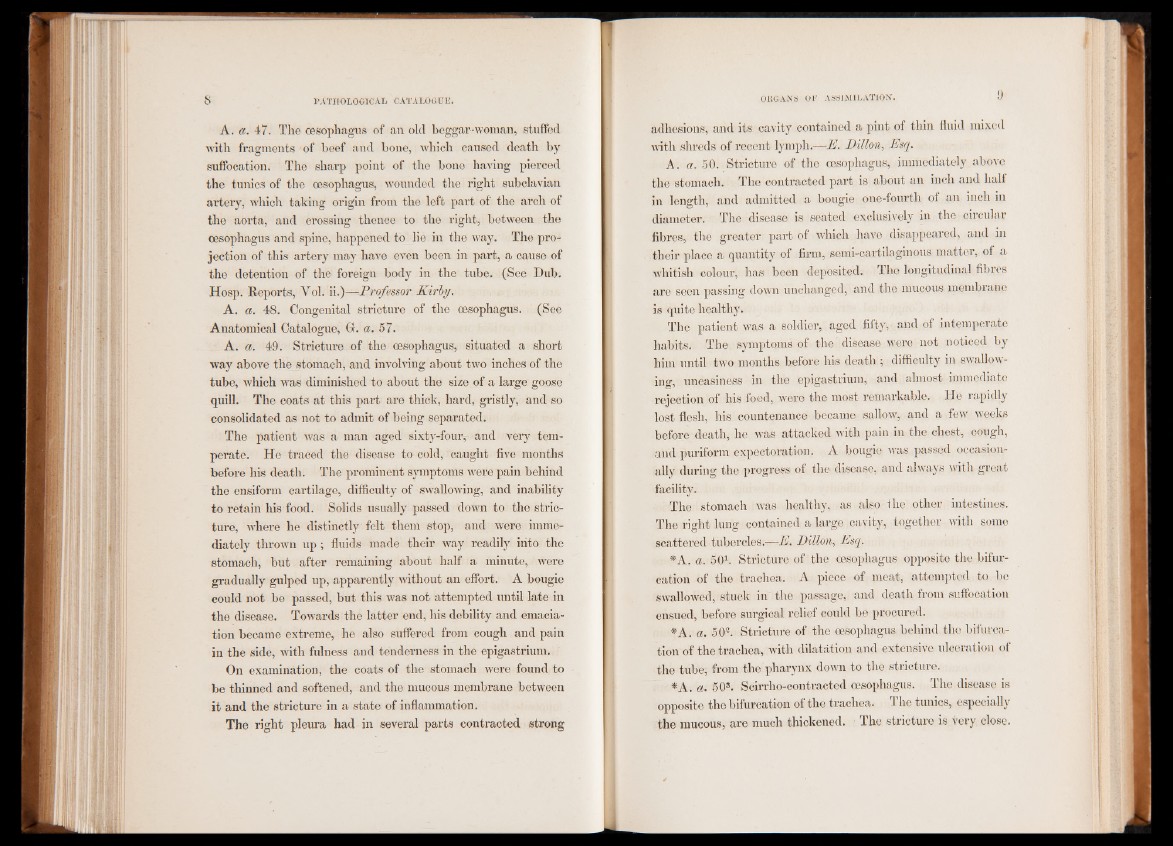
A. a. 47. The oesophagus of an old beggar-woman, stuffed
with fragments of beef and bone, which caused death by
suffocation. The sharp point of the bone having pierced
the tunics of the oesophagus, wounded the right subclavian
artery, which taking origin from the left part of the arch of
the aorta, and crossing thence to the right, between the
oesophagus and spine, happened to lie in the way. The projection
of this artery may have even been in part, a cause of
the detention of the foreign body in the tube. (See Dub.
Hosp. Reports, Yol. ii.)—Professor Kirby.
A. a. 48. Congenital stricture of the oesophagus. (See
Anatomical Catalogue, G. a. 57.
A. a. 49. Stricture of the oesophagus, situated a short
way above the stomach, and involving about two inches of the
tube, which was diminished to about the size of a large goose
quill. The coats at this part are thick, hard, gristly, and so
consolidated as not to admit of being separated.
The patient was a man aged sixty-four, and very temperate.
He traced the disease to cold, caught five months
before his death. The prominent symptoms were pain behind
the ensiform cartilage, difficulty of swallowing, and inability
to retain his food. Solids usually passed down to the stricture,
where he distinctly felt them stop, and were immediately
thrown up ; fluids made their way readily into the
stomach, but after remaining about half a minute, were
gradually gulped up, apparently without an effort. A bougie
could not be passed, but this was not attempted until late in
the disease. Towards the latter end, his debility and emaciation
became extreme, he also suffered from cough and pain
in the side, with fulness and tenderness in the epigastrium.
On examination, the coats of the stomach were found to
be thinned and softened, and the mucous membrane between
it and the stricture in a state of inflammation.
The right pleura had in several parts contracted strong
adhesions, and its cavity contained a pint of thin fluid mixed
Avith shreds of recent lymph.—E. Dillon, Esq.
A. a. 50. Stricture of the oesophagus, immediately above
the stomach. The contracted part is about an inch and half
in length, and admitted a bougie one-fourth of an inch in
diameter. The disease is seated exclusively in the circular
fibres, the greater part of which have disappeared, and in
their place a quantity of firm, semi-cartilaginous matter, of a
whitish colour, has been deposited. The longitudinal fibres
are seen passing down unchanged, and the mucous membrane
is quite healthy.
The patient was a soldier, aged fifty', and of intemperate
habits. The symptoms of the disease were not noticed by
him until two months before his death ; difficulty in swallowing,
uneasiness in the epigastrium, and almost immediate
rejection of his food, were the most remarkable. He rapidly
lost flesh, his countenance became sallow, and a few weeks
before death, he was attacked with pain in the chest, cough,
and puriform expectoration. A bougie was passed occasionally
during the progress of the disease, and always with great
facility.
The stomach was healthy, as also the other intestines.
The right lung contained a large cavity, together with some
scattered tubercles.—E. Dillon, Esq.
*A. a. 501. Stricture of the oesophagus opposite the bifurcation
of the trachea. A piece of meat, attempted to be
swallowed, stuck in the passage, and death from suffocation
ensued, before surgical relief could be procured.
*A. a. 50". Stricture of the oesophagus behind the bifurcation
of the trachea, with dilatation and extensive ulceration of
the tube; from the pharynx down to the stricture.
*A. a. 503. Scirrho-contracted oesophagus. The disease is
opposite the bifurcation of the trachea. The tunics, especially
the mucous, are much thickened. The stricture is very close.